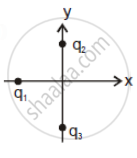Advertisements
Advertisements
Question
A proton and an electron are placed in a uniform electric field.
Options
The electric forces acting on them will be equal.
The magnitudes of the forces will be equal.
Their accelerations will be equal.
The magnitudes of their accelerations will be equal.
Solution
The magnitudes of the forces will be equal.
We know: \[\vec{F} = q \vec{E}\] For an electron and a proton, the value of q will be same, but the sign will be opposite.
Hence, they will experience a force that will be equal in magnitude but opposite in direction.
Now,
\[\vec{F} = q \vec{E} = m \vec{a} \]
\[ \Rightarrow \vec{a} = \frac{q \vec{E}}{m}\]
As the electron and proton have different values of mass m, they will have different magnitudes of acceleration. Also, they will differ in direction due to the opposite signs of q.
APPEARS IN
RELATED QUESTIONS
How does Ampere-Maxwell law explain the flow of current through a capacitor when it is being charged by a battery?
Two particles A and B with charges q and 2q, respectively, are placed on a smooth table with a separation d. A third particle C is to be clamped on the table in such a way that the particles A and B remain at rest on the table under electrical forces. What should be the charge on C and where should it be clamped?
The electric force experienced by a charge of 1.0 × 10−6 C is 1.5 × 10−3 N. Find the magnitude of the electric field at the position of the charge.
A positive charge Q is distributed uniformly over a circular ring of radius R. A particle of mass m, and a negative charge q, is placed on its axis at a distance x from the centre. Find the force on the particle. Assuming x << R, find the time period of oscillation of the particle if it is released from there .
A rod of length L has a total charge Q distributed uniformly along its length. It is bent in the shape of a semicircle. Find the magnitude of the electric field at the centre of curvature of the semicircle.
A smple pendulum consists of a small sphere of mass m suspended by a thread of length l. The sphere carries a positive charge q. The pendulum is placed in a uniform electric field of strength E directed vertically downwards. Find the period of oscillation of the pendulum due to the electrostatic force acting on the sphere, neglecting the effect of the gravitational force.
Answer the following question.
What is the magnitude of the charge on an electron?
Two parallel plates have a potential difference of 10 V between them. If the plates are 0.5 mm apart, what will be the strength of electric charge.
Electric charge is a property of ______.
In figure two positive charges q2 and q3 fixed along the y-axis, exert a net electric force in the + x-direction on a charge q1 fixed along the x-axis. If a positive charge Q is added at (x, 0), the force on q1 ______.
(1) |
(2) |
A solid sphere of radius R1 and volume charge density `rho = rho_0/"r"` is enclosed by a hollow sphere of radius R2 with negative surface charge density σ, such that the total charge in the system is zero. `rho_0` is a positive constant and r is the distance from the center of the sphere. The ratio R2/R1 is ______.
Electric field lines provide information about ______.
Total charge –Q is uniformly spread along length of a ring of radius R. A small test charge +q of mass m is kept at the centre of the ring and is given a gentle push along the axis of the ring.
- Show that the particle executes a simple harmonic oscillation.
- Obtain its time period.
Given below are two statements:
- Statement I: The electric force changes the speed of the charged particle and hence changes its kinetic energy; whereas the magnetic force does not change the kinetic energy of the charged particle.
- Statement II: The electric force accelerates the positively charged particle perpendicular to the direction of the electric field. The magnetic force accelerates the moving charged particle along the direction of the magnetic field.
In light of the above statements, choose the most appropriate answer from the options given below.
Two identical conducting spheres A and B, carry equal charge. They are separated by a distance much larger than their diameter, and the force between them is F. A third identical conducting sphere, C, is uncharged. Sphere C is first touched to A, then to B, and then removed. As a result, the force between A and B would be equal to ______.
A straight infinitely long cylinder of radius R0 = 10 cm is uniformly charged with a surface charge density σ = + 10-12 C/m2. The cylinder serves as a source of electrons, with the velocity of the emitted electrons perpendicular to its surface. Electron velocity must be ______ × 105 m/s to ensure that electrons can move away, from the axis of the cylinder to a distance greater than r = 103 m.
Two particles A and B having the same mass have charges +q and +4q, respectively. When they are allowed to fall from rest through the same electric potential difference the ratio of their speeds vA to vB will become ______.
